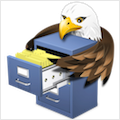

There is also a secondary Info (or Inspect) window.
#Eaglefiler youtube how to#
EagleFiler’s search really shines it’s based on Spotlight (so it can index any file that Spotlight knows how to index), but it uses its own index (making it super-fast) and its own straightforward Boolean syntax. In addition, at the very top of the window (in the toolbar) is a search field. So, the sidebar is itself a search mechanism, because you can select any combination of folders, smart folders, and tags to determine what’s listed in the top half of the window. You can create tags at will, and assign any number of them to a record and tags can be structured hierarchically. You can construct (through an excellent interface) some powerfully complex search criteria. As in Mail or the Finder, a smart folder is a saved set of search criteria clicking one performs the search, determining which records are listed at the top. The second sidebar section is smart folders. Here you can make new folders, put folders within folders, and organize records into folders these folders are real, reflecting and controlling the actual folder hierarchy within the library folder in the Finder. First comes a hierarchical list of folders. And on the left is a sidebar where you can select to specify the subset of records you want listed at the top. At the bottom are the contents of the record currently selected in that list. At the top is a list of files in the library (called “records”). The basic layout is reminiscent of Mail’s tripartite window. I’ll start by describing the library window.

Window on the World - Since EagleFiler’s data are just files in a folder, its chief value lies in its presentation of those files, and how it lets you annotate and search them.
#Eaglefiler youtube free#
However, in the modern scheme of things, where a hard disk will typically have dozens of gigabytes of free space, a few extra megabytes are hardly problematic. So, while 100 snippets of 10 bytes of text data apiece sum to about a kilobyte, 100 files of 10 bytes apiece require nearly a megabyte. Even a tiny text file occupies a minimum logical space on your hard disk – typically 8 KB. In the distant past, one might have criticized this scheme for wasting space. If the world were suddenly struck by mysterious cosmic rays that destroyed EagleFiler, none of your data would be lost, because your data are just normal files in folders. You can open them directly in the Finder. You can search your snippets within EagleFiler, but you can also search them with system-level Spotlight. But all the same, there are your snippets just sitting there, ordinary files in an ordinary folder, completely visible andĪccessible in the Finder. So you do have to make a conscious decision to keep particular snippets in a particular folder – the snippets can’t be scattered all over your hard disk – and you do need, in general, to refrain from altering the contents of that folder directly, interacting with them through EagleFiler instead. A library also contains some housekeeping files maintained by EagleFiler. That’s why I was intrigued by the lighter touch of EagleFiler, from C-Command (the development house of Michael Tsai, who also writes SpamSieve (see “ Tools We Use: SpamSieve,” 17įebruary 2003) and other utilities I wouldn’t want to be without).ĮagleFiler’s chief document type is called a “library.” You can have as many libraries as you like, and each library is just an ordinary folder in the Finder, containing files that are your data each snippet is simply a file in a standard data format.
#Eaglefiler youtube series#
In nearly two decades of experimenting with ways of storing and retrieving text and other snippets of information, largely documented in the “ Conquer Your Text” series of articles, I’ve found that most applications take a fairly heavyweight approach, requiring me to hand my data completely over to their care, keeping it in a specific place or (even more often) in a document and format specific to the application. #1650: Cloud storage changes for Box, Dropbox, Google Drive, and OneDrive quirky printing problem.#1651: Dealing with leading zeroes in spreadsheet data, removing ad tracking from ckbk.#1652: OS updates, DPReview shuttered, LucidLink cloud storage.#1653: Apple Music Classical review, Authory service for writers, WWDC 2023 dates announced.1654: Urgent OS security updates, upgrading to macOS 13 Ventura, using smart speakers while temporarily blind.


 0 kommentar(er)
0 kommentar(er)
